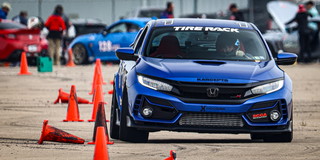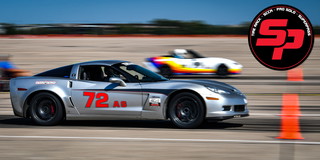
This article first appeared in the July, 2015 edition of SportsCar Magazine. SCCA members can read the current and past editions of SportCar digitally here after logging into their account; To become an SCCA member and get SportsCar mailed to your home address monthly in addition to the digital editions, click here.
Words by Jason Isley
Photo by Richard Dole
From the cage to the seat and fire system, the installation of safety equipment in a competition car is as important as the equipment itself
Safety equipment typically falls into one of two categories: the equipment you wear, and the equipment you install in the car. When it comes to outfitting the driver, it’s usually pretty easy: Make sure the items fit you properly and they have the proper rating stamps. Outfitting your car, on the other hand, features an entirely different level of complexity: installation.
Items like the roll cage are not things the beginner should tackle. Other items, like race seats and harnesses, can easily be installed with hand tools. Regardless of who installs it, you need to consult SCCA’s competition rulebook and the manufacturer’s recommendations.
All too often mistakes are made during the installation process that could result in injury in the event of an incident. So, when it comes to in-car safety, don’t be afraid to do more than the minimum required. The rules typically specify a minimum; so going beyond might buy you an added margin of safety.
From PDX to Solo to RallyCross and Club Racing, a roll cage or roll bar may be a requirement for your car, and this area is likely the most controversial. While Club Racing’s GCR gives specific guidelines for tubing size, attachment points, and general design guidelines, every builder seems to have their own take on what is best.
The roll structure is also one of the areas that is the most diverse in cost, from a few hundred dollars for a bolt-in roll bar to thousands of dollars for a custom-welded cage. For many classes, a pre-fabbed bolt-in roll structure will meet the requirements of the rules and provide an adequate level of safety. The advantage to the custom-built, welded roll structure is fit, for both the car and driver. A bolt-in unit is often designed to fit a road going car that may still have interior, potentially resulting in a smaller safety zone for the driver. A custom-built cage will fit closer to the interior body structure of the car, distancing the driver from the unforgiving tubing.
When it comes to sourcing a custom cage, you must have a competent welder and fabricator doing the work – this is, after all, your life at stake. Poor welds or improper installation can also result in the car not making it past tech and onto the track.
If you are shopping for a cage builder, some legwork can pay off, visit the track and look at other cars similar to yours, then see which design fits you best and ask other drivers for their experience with the builder they used.
A good cage fabricator can give you a rules-legal, safe design, with ample room for driver comfort, and a stiffer chassis that results in better suspension performance. Make sure to add padding to any parts of the cage your helmet or body may come in contact with – the GCR requires one-inch padding, and recommends using SFI or FIA approved products. Once again, exceeding the minimum requirement is always advisable.
If your car has a roll cage or bar, chances are you probably also have a race seat and, in Club Racing, they’re required. Race seats come in many shapes and sizes, made from a variety materials and sold in a range of colors. By sheer volume, the fiberglass shell FIA seat is the most common. Reasonably priced and available from most every seat manufacturer, these can be found in every discipline of SCCA amateur competition. The Kevlar and carbon fiber FIA seats are a little less common simply because of cost, but they offer a stronger shell and added safety. Aluminum shell seats are also popular due in part to their price point and flexibility of installation – you can literally bolt these to the floor, which is a handy feature for compact cars or taller drivers.
Like with all safety items, seats are a place you should go with the highest level you feel safe using. “I was in a car with a fiberglass seat that failed; a light bulb went on and I realized no one should be in one of these,” says Chad DiMarco of safety equipment supplier Sube Sports. “You should sit in the minimum of Kevlar, if not carbon fiber. The whole idea is for the seat to properly position your body when you absorb energy. Aluminum seats transfer energy. As soon as you back-brace a seat, it has no room to absorb energy...the occupant is going to see instant energy.”
Seat mounting is also drastically important. “Per FIA rules, the seat has to be mounted with the side mounts it was tested with,” says DiMarco. “The seat will only be as ridged as the mount it is put on. The seat is one half of the restraint system of the car; if the seat fails, we have a catastrophic event in the accident.
“The seat should be non-adjustable, it should be bolted directly into the four holes in the floor that have been load tested by the manufacturer in a production car,” DiMarco continues. “In a many racecars we run crossbars attaching to the tunnel and the side rail, which are welded in. The side mounts are mounted to those tubes.”
Seat fitment is not just about comfort; it’s also about safety. “The criterion for seat fitment is hipbone,” says DiMarco. “In other words, your weight doesn’t really matter, it’s how wide your hipbones are from side to side. Most people are within 15 or 16 inches – 99 percent of people will fit in that range.
“With lateral g-force you are going to decrease your hipbone width by an inch, so generically what we tell people is what fits tightly in the showroom will fit you properly on the race course. What is comfortable in the showroom will be loose and unsupportive on the track.”
Like seats, harnesses come in a seemingly endless range; two-inch wide straps, three-inch wide straps, pull-up buckles, pull-down buckles, camlock and duckbill latches, aluminum or steel hardware, and lots of colors. For Club Racing, an SFI or FIA harness can be used for five years from its date of manufacture, while Solo and RallyCross don’t age out the belts.
According to Jeff Paulk of HMS Motorsport, belt fitment is key. “We recommend a two-inch lap belt,” Paulk explains. “It offers better comfort and ease of adjustment.”
“The main premise behind the two-inch lap belt is one of added safety,” explains a fact sheet on HMS Motorsport’s website. “A two-inch belt rides within the crest of the human pelvis where a three-inch belt would rest on the edges. This allows you to get the belt up to an inch and a half tighter. That means the lap belt will be working earlier in the accident event because it gets loaded faster. It's also more comfortable and easier to adjust because there's less friction through the adjuster.”
You have the same option for shoulder belt width, and many head and neck restraints fit better with a narrower two-inch belt.
Belt attachment to the car typically comes as a clip in, bolt in, or wrap around design, or a combination. It’s important that they be properly installed for optimum protection. All too often, however, small mistakes can be found. “On the sub strap you really want them straight down to 20 degrees back,” says Paulk, who also notes that the shoulder belts are another place errors are made. “Forgetting the final wrap to lock the shoulder belts in place is the biggest mistake we see at the track.”
While not required, the center net is gaining in popularity, particularly in applications where a containment seat is not a good fit. The center net is designed to help support the head and upper body and, in some applications, you may even see them on both sides of the seat.
When installing the center net, you want it about shoulder height, making sure it does not obstruct your vision or use of the shifter. “You want it to capture your head and shoulders,” explains Paulk.
The last thing a driver should be thinking about is putting out a fire – the first order of business is safely getting out of the car, but this is where a fire suppression system is helpful. With a fire system, you can pull the lever and let the system work while you are escaping danger. The prices for complete fire suppression systems are now quite reasonable, and they typically require little more maintenance than a handheld fire bottle. Installation for some can be done without any special tools, while others may require as little as a flaring tool.
While your budget may partially dictate what safety items you choose to install in your competition car, always keep in mind the potential cost of not using high-quality products that are installed properly. Once all the safety items are correctly bolted into place, you can rest easy and go win.










